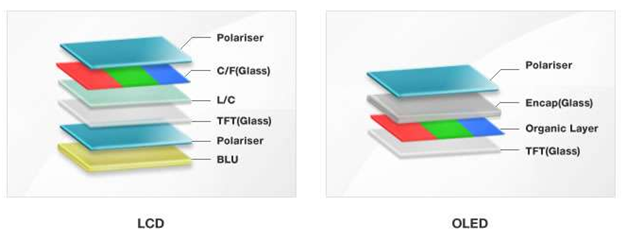What Are the Differences Between OLED and LED?
LED (Light Emitting Diode) and OLED (Organic Light Emitting Diode) operate along the same principals, but in actuality the way they function are different. The most basic difference is that each in OLED, each pixel provides its own illumination, while all of the pixels in an LCD screen are illuminated by an LED backlight. LED screens are LCD screens with LEDs in place that backlight the pixels of an LCD, since they do not emit any illumination of their own.
The three types of LED technology that primarily used are white-edge LEDs, LED arrays, and dynamic LEDs. White-Edge LEDS are placed around the edge of the screen. They use a diffusion panel to spread the light produced by the LEDs evenly behind the screen. LED arrays are arranged behind the screen and the brightness can’t be controlled individually. Dynamic LEDs are an array of LEDs controlled either individually or in clusters so that the LEDs can be dimmed locally to modulate the backlight light patter.
OLED uses organic material, in the form on carbon, to provide a natural light source to light the display. This allows for OLED screens to be bigger, lighter, and retain consistent color from even the widest viewing angles. The two types of OLED technology available are RGB and white OLED. In RBD OLED, the red, green, and blue pixels are sandwiched together. When a current passes through the pixels, a white light is created. This light, in turn, passes through a color filter dividing it into the respective variations of the colors of red, green, and blue that forms the picture. In white OLED, the light produced begins as a white color. It then passes through the color filter, which in turn produces the colors seen on the screen. This type of OLED display is thought to be superior to the RGB OLED displays due to the longer life of the white OLEDs and the less chance of color shift.
The differences between LED and OLED include illumination methods, price points, and energy efficiency levels. The main difference between an LED and OLED screen is that the pixels of an OLED screen are self-illuminating, whereas the LED are used to light an LCD display. OLED screen features a wider viewing angle than do LED screens. With OLED, the colors do not get washed out when viewers watch from extreme angles. OLED offers the ability to develop lighter and thinner displays than LED screens do. OLED screens are more energy efficient when compared to their LED counterparts. LED LCDs and OLED ties in terms of resolution, lifespan, and burn-in.
LCD is preferable for light output (brightness), refresh rate and motion blur, high dynamic range (HDR), expanded color gamut, and energy consumption. The whole LCD screen can be brighter than LED due to the backlight. OLED cannot do a full screen as bright, but parts of the image can be as bright, or brighter, than many LCDs. Refresh rate is important in reducing motion blur, or the blurring of anything on screen that moves, which LCD is good for. HDR significantly improves picture quality. It is an expansion of contrast ratio, an improvement in brightness, and more. The energy consumption of LCD only varies depending on the backlight setting. The lower the backlight, the lower the power consumption. A basic LED LCD with its backlight set low will draw less power than OLED.
OLED wins in the categories of black level, contrast ratio, viewing angle, and uniformity. OLED has the ability to turn off individual pixels completely. It can produce truly perfect black. For contrast ratio, OLED can get nearly as bright as LCD plus it can produce absolute black with no blooming. It has the best contrast ratio of any modern display. For viewing angles, OLED doesn’t have the off-axis issue LCDs have so its image looks the same even from extreme angles. Uniformity refers to the consistency of brightness across the screen. LED LCDs “leak” light from their edges.





